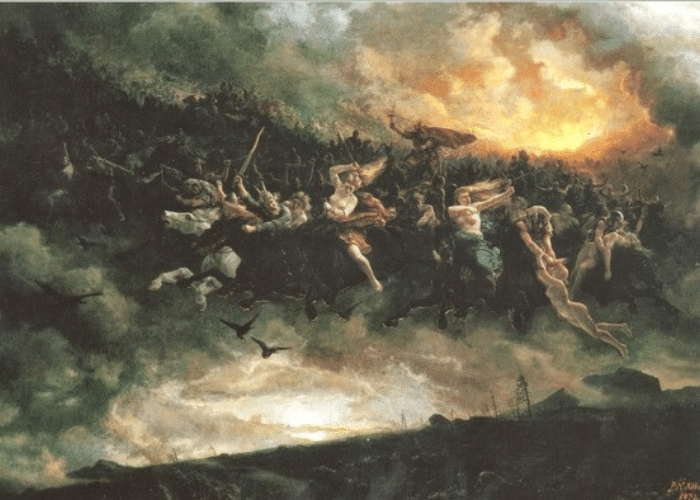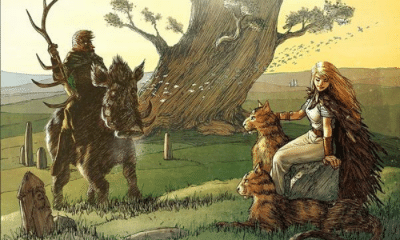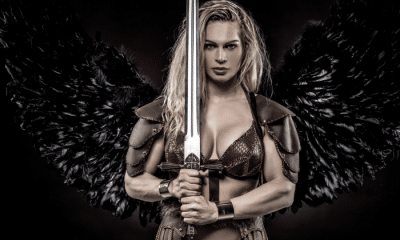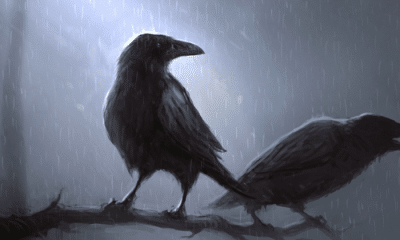
Norse
The Aesir-Vanir War
The Aesir-Vanir War
The last battle of Ragnarök may be their most famous, but did you know that the gods of the Norse people once waged war among themselves?
The Norse believed in two races of gods. The Aesir lived in Asgard while the Vanir made their home in Vanaheim.
In the most familiar myths, these two groups of gods worked together. This was not always the case, however.
Early in their history, the Aesir and Vanir had gone to war with one another.
The Aesir-Vanir War may not be the most well-known event in Norse mythology, but it proved to be one of the most important. The war and its results would shape the way the Norse people viewed their gods and, perhaps, give historians a glimpse into how they developed.
The War Between the Aesir and Vanir Gods
Several surviving sources mention a long and violent war that took place between the two races of Norse gods.
The war is sometimes said to have begun when the Aesir grew jealous of the Vanir’s popularity among the human population. Although the Aesir received more sacrifices, the Vanir were well-loved and began to demand an equal share.
The Poetic Edda’s Völuspá, however, gives another origin for the conflict. According to this poem, the war began when a goddess called Gullveig went to Asgard.
Although Gullveig, also called Heiðr, is otherwise unknown in Norse legends it is obvious from the poem that she was a Vanir goddess. She practiced seidr, the shamanic magic associated with Vanaheim.
The Aesir attacked Gullveig, stabbing her with spears and burning her body. In her magical trance, however, she was able to survive three such attacks.
Although the poem does not make it entirely clear, the attack on Gullveig seems to have sparked the war. The Aesir viewed her as a spy or saboteur, while the Vanir saw the attack as the attempted murder of one of their own.
One of the most famous scenes of the war was during the first battle. Odin, the chief of the Aesir, threw his spear into the ranks of the Vanir to begin the fight.
In Norse culture, this became a standard ritual. Warriors would throw a spear into the enemy lines to proclaim that their deaths would be sacrifices to Odin.
Few details of the war are giving in existing sources. It is clear, however, that the fighting was intense.
The Aesir are generally imagined as the more war-like of the two groups, but the Vanir “know how to tread the field” as well. Both sides caused significant damage to the other’s lands.
We know, for example, that the walls of Asgard were nearly destroyed by the fighting. The need to rebuild them set the backdrop for the legend of how Loki gave birth to Odin’s horse, Sleipnir.
As the war dragged on, the Vasir actually seemed to have the upper hand. It was clear, however, that neither side would entirely prevail.
The gods convened to determine whether the Aesir should pay a fine to the Vanir or share a greater portion of the humans’ sacrifices going forward. Ultimately, it was decided that the Aesir and Vanir would be treated as equals.
To symbolize the peace deal that had been struck between them, all the gods of the Aesir and Vanir spit into a single vessel. This mixed to form Kvasir, a supremely intelligent man whose blood would later make the Mead of Poetry.
The two groups also exchanged members. These gods not only served as symbols of the new union, but were also hostages to ensure the peace was maintained.
Hoenir went to the Vasir while their wealthiest god, Njörðr, was given to the Aesir. Kvasir remained in Asgard while Mímir, the wisest god in Asgard, moved to Vanaheim.
Njörðr was joined by his children, Freyr and Freyja. The three soon settled into Asgard and introduced seidr magic, became important deities among the Aesir.
Hoenir and Mímir, however, had less luck with the Vanir.
Because he was handsome and strong, the Vanir elected Hoenir to be their leader. Mímir gave him wise advice as his chief counselor. When they were around the other Vanir gods, however, Mímir always told Hoenir that he should let others made decisions.
This, of course, was because Hoenir’s handsomeness did not make him a wiser leader than the other Vanir. They took it to mean, however, that they had been cheated and Mímir was not as wise as the Aesir had lead them to believe.
The Vanir beheaded Mímir and sent his head back to Odin. While this could have restarted the war, Odin was able to magically revive and preserve the head so Mímir instead returned to counsel him and the Aesir.
Although the Vanir had not lost the war, the Aesir remained somewhat more powerful. Odin became the de facto head of all of the gods, although the Vanir maintained their own home in Vanaheim.
Worship among the humans, however, was shared more equally. While Aesir gods like Odin and Thor still received many sacrifices, people also paid homage to the Vanir gods of prosperity and fertility.
My Modern Interpretation
Although some historians believe that the Aesir-Vanir War has little to no broader meaning, others believe that the ancient history of Scandinavia is hinted at in its descriptions.
The coexistence of the Aesir and Vanir is somewhat unique. While other mythologies, such as those of Greece and Ireland, describe wars between two groups of gods the outcomes were much different.
In Ireland, the Tuatha Dé Dannan prevailed over both the Fir Bold and the Fomorians. While some half-Fomorian gods became important, the Tuatha Dé Dannan ultimately held power in Ireland.
In Greece, the Olympians battled the Titans for supremacy. The older gods were completely destroyed and sent to Tartarus.
The peace treaty between the Aesir and Vanir, however, allowed two groups of gods to coexist and intermingle as equals. This unique dual pantheon has led some historians to believe there may be a deeper meaning to the story.
Many of the Aesir gods have clear ties to other Germanic cultures. Odin, for example, was worshiped throughout Northern Europe as Woden or Wuotan in a form very similar to the Scandinavian character.
Many of the Vanir gods, however, have no such parallels. Some, like Freyja, seem to have no links to other Germanic religions while others, like Njörðr, have only tenuous theoretical ties to the rest of Europe.
As a whole, the Vanir seem to be distinctly Scandinavian gods. The Aesir, however, have strong ties to other Germanic cultures and wider Indo-European archetypes.
Some historians have thus theorized that the two groups of gods actually came from two different cultures. The Aesir-Vanir War reflects, in a myth, the conflict between two human groups.
This theory holds that, at some point in their history, the Germanic people who worshipped Odin and the Aesir gods came into contact with another group who worshipped the Vanir.
It is unknown who this second group of people were. Historical records from Nordic countries do not exist until well into the Roman era, and Latin writers made few distinctions between the northern cultures.
If this historical interpretation is correct, however, it is likely that the secondary culture was absorbed into that of the Germanic Norse by this time. The treaty between the Aesir and Vanir, with its exchange of knowledge and gods, could represent the way in which two human cultures learned to coexist.
The Aesir, the Germanic gods, remained more prominent. They adopted the magic of the Vanir, however, and figures like Njörðr, Freyr, and Freyja were brought into the pantheon.
That magic, however, may provide a clue as to who the Germanic Norse people encountered.
The Sámi are indigenous to Norway, Sweden, Finland, and parts of Russia. Their languages belong to the Finno-Ugric family, making them related to modern Finnish, Estonian, and Hungarian rather than the other Indo-European languages of Europe.
Both the Sámi and the Norse are believed to have lived in Scandinavia from at least the Bronze Age, possibly earlier. Although they retained unique cultures, it is likely that they came into contact with one another to some extent over their history.
The traditional Sámi religion was shamanistic. While they did not have gods that can be immediately recognizable as the Vanir, the emphasis on the earth and magic does bring those gods to mind.
Seidr, the magic the Vanir brought to Asgard, is usually identified as shamanistic practice. Unlike the rituals that took place in temples, it was focused on the individual’s connection with the world and the forces of nature.
And while the Sámi religion did not have the same type of pantheon as that of the Germanic people, it focused on many of the same elements as the Vanir gods. Like them, it was associated more with fertility, prosperity, and the land than the more war-like Aesir gods were.
Like the Aesir and Vanir gods, the Norse and Sámi peoples had their own distinct homelands and cultures. Based in the Arctic north, the Sámi traditionally had little direct interaction with their more southern neighbors and did not directly compete for land or resources.
This may not have always been the case, however. It is possible that early interaction between the Germanic Norse and the indigenous Sámi was one source of inspiration for the myth of two groups borrowing from on another and sharing Scandinavia.
In Summary
In Norse mythology, there were two groups fo gods. The Vanir are usually interpreted as gods of fertility and prosperity, while the Aesir were more war-like and focused on strength.
According to legend, the two groups went to war with one another. Begun by the attempted murder of a Vanir goddess in Asgard, the Aesir homeland, and conflicts over sacrifices, the war caused significant damage to the homelands of both groups.
While the Aesir were more focused on war, the Vanir used magic to a greater degree. As a result, the Vanir were able to push back against the Aesir.
Eventually, the two sides tired of the fighting and agreed to a truce. They sealed this by spitting into a vat, creating Kvasir.
Kvasir, Njörðr, and Njörðr’s childre were sent to Asgard. In exchange, the Vanir took Hoenir and Mímir from the Aesir.
This unique story of gods coexisting and exchanging both members and knowledge has led some historicans to believe that the myth was inspired by interactions by human groups in the prehistoric past.
The Aesir are closely linked to other Germanic and Indo-European cultures, but the Vanir seem to be exclusive to Scandinavia. This, along with their different domains, may indicate that they came from different cultures.
One possibility is the Sámi, a Finno-Ugric group indigenous to Northern Scandinavia. Their shamanistic religion may have inspired the seidr magic associated with the Vanir.
While the identity of the non-Germanic group that inspired the Vanir may never be known for sure, the Sámi are one group that was known to maintain a distinct homeland and culture in close proximity to the Norse. The story of the Aesir-Vanir War may reflect how they, or another group, came to live alongside the Germanic Norse people.









